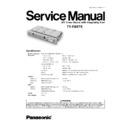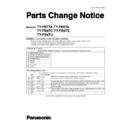Read Panasonic TY-FB9TE Service Manual online
TY-FB9TE
U/V Tuner Board with Hospitality Port
Specifications
Receiving Systems /
Band name
Band name
PAL B, G, H, SECAM B, G SECAM L / L´
VHF E2 - E12
VHF H1 - H2 (ITALY)
VHF A - H (ITALY)
UHF E21 - E69
CATV (S01 - S05)
CATV S1 - S10 (M1 - M10)
CATV S11 - S20 (U1 - U10)
CATV S21 - S41 (Hyperband)
PAL D, K, SECAM D, K
VHF R1 - R2
VHF R3 - R5
VHF R6 - R12
UHF E21 - E69
PAL 525/60
Playback of NTSC tape from some PAL Video re cord ers (VCR)
M.NTSC
Playback from M. NTSC Video recorders (VCR)
NTSC (AV input only)
Playback from NTSC Video recorders (VCR)
OUTPUT
AUDIO OUT
AUDIO L-R (RCA Pin Type × 2)
0.5 Vrms
VIDEO OUT
VIDEO (BNC Type)
1.0 Vp-p (75
W)
Others
Ir System terminal × 1
INPUT
AUDIO IN
AUDIO L-R (RCA Pin Type × 2)
0.5 Vrms
VIDEO IN
VIDEO (BNC Type)
1.0 Vp-p (75
W)
S-VIDEO (MINI DIN 4-pin)
Y:1.0 Vp-p (75
W) C:0.286 Vp-p (75 W)
ANT-IN
UHF / VHF
Mass (Weight)
0.55 kg
ORDER NO. ITD0608050CE
1 Safety Precautions
3
1.1.
General Guidelines
3
1.2.
Touch-Current Check
3
2 Prevention of Electro Static Discharge (ESD) to
Electrostatically Sensitive (ES) Devices
4
3 About lead free solder (PbF)
5
4 Installation
6
5 Antenna connection
7
6 Connections of external equipment
8
7 Circuit Board Layout
9
7.1.
HE-Board
9
8 Block and Schematic Diagram
11
8.1.
Schematic Diagram Notes
11
8.2.
HE-Board Block Diagram
12
8.3.
HE-Board (1 of 8) Schematic Diagram
13
8.4.
HE-Board (2 of 8) Schematic Diagram
14
8.5.
HE-Board (3 of 8) Schematic Diagram
15
8.6.
HE-Board (4 of 8) Schematic Diagram
16
8.7.
HE-Board (5 of 8) Schematic Diagram
17
8.8.
HE-Board (6 of 8) Schematic Diagram
18
8.9.
HE-Board (7 of 8) Schematic Diagram
19
8.10. HE-Board (8 of 8) Schematic Diagram
20
9 Replacement Parts List
21
9.1.
Replacement Parts List Notes
21
9.2.
Electrical Replacement Parts List
22
9.3.
Mechanical Replacement Parts List
28
9.4.
Parts Location (1)
29
9.5.
Parts Location (2)
30
10 Schematic Diagram for printing with A4
31
CONTENTS
Page
Page
2
TY-FB9TE
1 Safety Precautions
1.1. General Guidelines
1. When servicing, observe the original lead dress. If a short circuit is found, replace all parts which have been overheated or
damaged by the short circuit.
2. After servicing, see to it that all the protective devices such as insulation barriers, insulation papers shields are properly
installed.
3. After servicing, make the following leakage current checks to prevent the customer from being exposed to shock hazards.
1.2. Touch-Current Check
1. Plug the AC cord directly into the AC outlet. Do not use an isolation transformer for this check.
2. Connect a measuring network for touch currents between each exposed metallic part on the set and a good earth ground such
2. Connect a measuring network for touch currents between each exposed metallic part on the set and a good earth ground such
as a water pipe, as shown in Figure 1.
3. Use Leakage Current Tester (Simpson 228 or equivalent) to measure the potential across the measuring network.
4. Check each exposed metallic part, and measure the voltage at each point.
5. Reserve the AC plug in the AC outlet and repeat each of the above measure.
6. The potential at any point (TOUGH CURRENT) expressed as voltage U
4. Check each exposed metallic part, and measure the voltage at each point.
5. Reserve the AC plug in the AC outlet and repeat each of the above measure.
6. The potential at any point (TOUGH CURRENT) expressed as voltage U
1
and U
2
, does not exceed the following values:
For a. c.: U
1
= 35 V (peak) and U
2
= 0.35 V (peak);
For d. c.: U
1
= 1.0 V,
Note:
The limit value of U
2
= 0.35 V (peak) for a. c. and U
1
= 1.0 V for d. c. correspond to the values 0.7 mA (peak) a. c. and 2.0
mA d. c.
The limit value U
The limit value U
1
= 35 V (peak) for a. c. correspond to the value 70 mA (peak) a. c. for frequencies greater than 100 kHz.
7. In case a measurement is out of the limits specified, there is a possibility of a shock hazard, and the equipment should be
repaired and rechecked before it is returned to the customer.
Figure 1
3
TY-FB9TE
2 Prevention of Electro Static Discharge (ESD) to
Electrostatically Sensitive (ES) Devices
Some semiconductor (solid state) devices can be damaged easily by static electricity. Such components commonly are called
Electrostatically Sensitive (ES) Devices. Examples of typical ES devices are integrated circuits and some field-effect transistors and
semiconductor "chip" components. The following techniques should be used to help reduce the incidence of component damage
caused by electro static discharge (ESD).
1. Immediately before handling any semiconductor component or semiconductor-equipped assembly, drain off any ESD on your
Electrostatically Sensitive (ES) Devices. Examples of typical ES devices are integrated circuits and some field-effect transistors and
semiconductor "chip" components. The following techniques should be used to help reduce the incidence of component damage
caused by electro static discharge (ESD).
1. Immediately before handling any semiconductor component or semiconductor-equipped assembly, drain off any ESD on your
body by touching a known earth ground. Alternatively, obtain and wear a commercially available discharging ESD wrist strap,
which should be removed for potential shock reasons prior to applying power to the unit under test.
which should be removed for potential shock reasons prior to applying power to the unit under test.
2. After removing an electrical assembly equipped with ES devices, place the assembly on a conductive surface such as alminum
foil, to prevent electrostatic charge buildup or exposure of the assembly.
3. Use only a grounded-tip soldering iron to solder or unsolder ES devices.
4. Use only an anti-static solder removal device. Some solder removal devices not classified as "anti-static (ESD protected)" can
4. Use only an anti-static solder removal device. Some solder removal devices not classified as "anti-static (ESD protected)" can
generate electrical charge sufficient to damage ES devices.
5. Do not use freon-propelled chemicals. These can generate electrical charges sufficient to damage ES devices.
6. Do not remove a replacement ES device from its protective package until immediately before you are ready to install it. (Most
6. Do not remove a replacement ES device from its protective package until immediately before you are ready to install it. (Most
replacement ES devices are packaged with leads electrically shorted together by conductive foam, alminum foil or comparable
conductive material).
conductive material).
7. Immediately before removing the protective material from the leads of a replacement ES device, touch the protective material
to the chassis or circuit assembly into which the device will be installed.
Caution
Caution
Be sure no power is applied to the chassis or circuit, and observe all other safety precautions.
8. Minimize bodily motions when handling unpackaged replacement ES devices. (Otherwise hamless motion such as the brushing
together of your clothes fabric or the lifting of your foot from a carpeted floor can generate static electricity (ESD) sufficient to
damage an ES device).
damage an ES device).
4
TY-FB9TE


